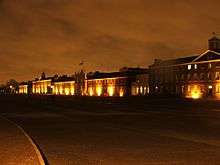1983 Royal Artillery Barracks bombing
| 1983 Royal Artillery Barracks bombing | |
|---|---|
 The Royal Artillery Barracks in London | |
| Location | London, United Kingdom |
| Date |
10 November 1983 Unknown (GMT) |
| Target | Military |
Attack type | Time bomb |
| Deaths | 0 |
Non-fatal injuries | 5 |
| Perpetrator | Provisional Irish Republican Army |
Suspected perpetrator | Scottish National Liberation Army |
On 10 December 1983 a bomb exploded at the Royal Artillery Barracks in Woolwich, South East London. The explosion injured five people and caused minor damage to the building. The bomb exploded in a guard room, leaving a crater 15 feet (4.6 m) deep. A Christmas party was underway in the Sergeants' Mess, around 300 yards (270 m) away, when the bomb exploded. The Scottish National Liberation Army claimed responsibility for the bombing, stating that "more will follow",[1] although Scotland Yard believed that the IRA were behind the attack.[2][3] The IRA later admitted responsibility for the attack.[4]
Post Event Witness Account:
1. At the time of this bombing I was working for the government building agency responsible for the Woolwich Barracks - in fact I had attended a meeting on the preceding working day in the government building opposite, where the bomb went off and this building and the adjacent multistorey married quarters had their windows blown out by the explosion.
2. If I remember correctly the timing of the explosion was fortunate for those married quarters occupants as they were predominately on the other side of the building from the explosion when it went off, otherwise the injuries to men, women and children, particularly from flying glass would have been horrendous.
3. Myself and a colleague were compelled to attend the scene the next working day after the explosion and I can verify the following:
a. There was not aa large a crater as described in the press reports it was probably about 1m deep at the most but was probably perhaps 3 metres diameter (although through concrete paving stones) -
b. The report at the time was that this was a carrier bag or similar bomb placed in a ridiculously vulnerable access point of a pavement set back from a bus stop which ran very close to a railing fence and a blank wall of the guard house sleeping accommodation.
c.The end wall had been blown inwards and the building was in a state of partial collapse.
d. The guards injuries whilst reported as quite serious, being mainly pressure/hearing related were mitigated by two factors: i. by luck a new toilet and washbasin room had been built internally in brick\blockwork against the whole of the end wall in question and this formed a valuable baffle which significantly reduced the blast effect, ii. also whilst there was a flat roof (I cant remember if it was concrete or timber) there were also pyramid shaped plastic\glass rooflights which as these had been blown upwards by the blast and then settled back had also reduced the pressure of the explosion in the sleeping area where the guards that were injured were when the explosion took place.
GP 2016
See also
References
- ↑ "Bombing injures 5 in British barracks". The Gainesville Sun. 11 December 1983.
- ↑ "Leaders guarded as IRA blitz feared". The Hour. 12 December 1983.
- ↑ "198306280006". Global Terrorism Database. National Consortium for the Study of Terrorism and Responses to Terrorism.
- ↑ I Guardian